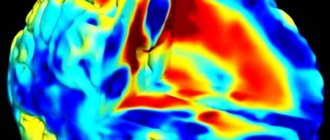Schizophrenia is a type of mental disorder that is manifested by the breakdown of thought processes, perceptions, and emotional reactions. One of the significant characteristics of the disease is its polymorphism, that is, the variety of symptoms.
Schizophrenia is diagnosed in women as often as in men, but it develops at a later age. If in males the disease manifests itself at the age of 20-28, then in women the diagnosis is made between the ages of 26 and 32. Children and elderly people rarely suffer from the pathology. The onset of the disease is not typical for older people.
Schizophrenia rarely occurs on its own; it is combined with depression, anxiety disorders, and alcoholism. Patients are prone to suicide attempts.
Women living in cities suffer from schizophrenia more often than rural women. The reasons for this fact remain unclear to date.
In the development of the disease, heredity plays a significant role. Other risk factors include:
- psychological trauma;
- abnormalities of brain development;
- stress;
- childhood violence;
- features of raising girls;
- pregnancy, etc.
Scientists agree that schizophrenia is a multifactorial disease.
Reasons for the development of the disease
The most common cause of schizophrenia is considered to be a hereditary factor . If both parents suffer from this disease in a family, the possibility of their child acquiring this mental disorder is 50%. Children are at risk, even if this diagnosis occurred in the family several generations ago.
Signs of schizophrenia in young women are observed against the background of a sharp change in hormonal levels - during pregnancy and after childbirth. Other reasons may be:
- viral infections suffered during pregnancy;
- birth, traumatic brain, psychological trauma;
- long-term use of alcoholic beverages and drugs;
- cases of physical or sexual violence that occurred in childhood.
Sluggish schizophrenia. What it is? Reasons for appearance
Sluggish, latent, or low-progressive schizophrenia. The main feature of this type of schizophrenia is the slow progression of the disease and, as a rule, the presence of only indirect clinical manifestations: neurosis-like, psycho-like, affective, hypochondriacal, etc., and shallow changes in a person’s personality. However, the ICD-10 list does not include the diagnosis of “sluggish schizophrenia”.
It is quite difficult to clearly determine the cause of schizophrenia. Currently, there are several versions of the sources of this disorder:
- hereditary predisposition;
- failure of the biochemical activity of neurotransmitters in the brain;
- negative impact of constant stress;
- the presence of certain social factors that negatively affect the education (formation of the psyche) of a person.
Stages of schizophrenia in women
The development of the disease goes through several stages.
First stage
During this period , signs are usually mild. Therefore, they are not paid attention to or taken for granted, as a feature of a person’s character and behavior. The patient is characterized by mood swings and emotional problems.
Adaptation stage
It is at this stage, most often, that the patient’s relatives seek help from a specialist who establishes an accurate diagnosis. It is no longer possible to ignore the symptoms of schizophrenia. They can manifest themselves as hallucinations, delusional ideas, and a sharp change from attacks of aggression to apathy. A person stops adequately perceiving reality.
Degradation stage
Emotions and desires become dull, a person becomes weak-willed .
In the absence of treatment, the consequences of the development of the disease are sad - the patient loses self-care skills, falls into a state of apathy, and degrades.
Features of the course of female schizophrenia
Female schizophrenia has a number of differences. Among them:
- Late start. The first noticeable attack occurs around the age of 30.
- Schizophrenia hidden from most others. A sluggish disease leads to the fact that its treatment is postponed indefinitely.
- Long-term depression.
- Tendency to hysterics.
- Excessive irritability.
Difficulties in diagnosis are explained by the fact that women are characterized by increased emotionality. Bad mood and aggression are often attributed to premenstrual syndrome and hormonal changes. Therefore, latent schizophrenia can be diagnosed even several decades after its manifestation.
Some scientists tend to consider pregnancy a trigger factor for the development of the disease. However, the birth of a child can become critical only for those patients who have a genetic predisposition to mental disorders.
These women experience severe postpartum depression, which can be combined with symptoms of schizophrenia. The situation is aggravated by lack of communication, hormonal changes, stress experienced during childbirth, and responsibility for the newborn. If the manifestations of pathology are not recognized in time, the patient can harm not only herself, but also the child.
Schizophrenia is not a reason to terminate a family. Sick women can become mothers and reproduce healthy offspring.
Symptoms and signs of schizophrenia in women
Changes in the emotional sphere
A woman is characterized by mood swings, from one extreme to another. A couple of minutes ago she could have been in a state of causeless euphoria, which then abruptly gives way to a flash of anger, rage or aggression. As the disease progresses, such changes will be permanent and continuous.
A woman reacts inappropriately to various news. She may laugh loudly when she is told about a tragic incident, and, conversely, cry if she is told a funny story or joke. Spontaneity in expressing emotions is another sign of the disease. The patient may suddenly begin to sing or dance in a public place in an environment that is not at all conducive to this kind of entertainment.
The patient is subject to bursts of irritability, unreasonable and frequent hysterics. The other extreme is indifference and a clear scarcity of emotions. A person stops smiling, rejoicing, and being interested in previously loved hobbies and hobbies. Apathy gives rise to a change in attitude towards family members. She may accept the news of the loss of a loved one with indifference. A woman with schizophrenia stops paying attention to her children. If they are still small and are not able to take care of themselves, they remain hungry, unwashed, unkempt and unkempt.
Cognitive impairment
The disease affects all mental functions of a person. The woman's memory is deteriorating. She cannot remember important, memorable dates, the birthdays of her loved ones. The patient loses the ability to draw logical conclusions and solve simple mathematical problems. A person becomes distracted, has problems concentrating, and cannot concentrate on one thing.
Changing speech
A sign of schizophrenia in women is speech impairment. Depending on the form of mental disorder, it becomes inhibited or, conversely, too active. The patient saturates her with ornate, complex turns of phrase. When speaking, he may lose the endings of words or phrases. The woman invents her own language, which she considers very beautiful, but only she understands it. Her reasoning becomes incoherent, devoid of logic.
The patient jumps from one topic to another, while losing the very essence of the conversation. Loud exclamations and uttering fragmentary phrases out of place, without taking into account the content and meaning of the conversation, are also a sign of speech impairment.
Symptoms of schizophrenia in women - changes in behavior
The faster the disease progresses, the more severely it affects behavioral deformation . The first signs of schizophrenia in women are expressed in isolation and detachment. A person does not want to get in touch with his friends and acquaintances, and later relationships with family members deteriorate.
As the disease progresses, changes in behavior become more noticeable. Their manifestations depend on the form of schizophrenia. So, for example, a previously shy and modest woman begins to behave defiantly. He dresses flashily and unattractively, turns things inside out, and applies aggressive makeup. Such changes are especially noticeable if they were not characteristic of the patient before.
a symptom of schizophrenia in women . They cannot stand criticism and condemnation addressed to them. In response to a remark made or a “wrongly spoken” word, they may rush with their fists and start kicking.
A characteristic sign of the disease is inappropriate spending. A person spends all his accumulated savings on an expensive branded item. Patients also tend to create household rituals that they strictly follow. For example, they wipe a chair a certain number of times before sitting on it, and regularly move things from one place to another. If the sequence of these actions is disrupted, the patient loses count or places an object in the wrong place, she may have an attack of panic attack or aggression.
If at least a few of the above signs and symptoms of schizophrenia a woman’s behavior , this is a reason for concern for her relatives. The patient herself is unlikely to notice the strangeness and eccentricity of her actions, therefore the initiative and responsibility for timely contact with a specialist often lies with loved ones. Remember, the earlier the diagnosis is made and treatment started, the greater the patient’s chances of returning to a full life.
Contact the “Balance” clinic by phone +7 (499) 495-45-03. Our specialists will definitely help you . We employ experienced psychiatrists who are proficient in modern diagnostic techniques. They will talk with the patient, identify signs characteristic of schizophrenia, and classify its form and stage of development. Based on the results of the examination, effective medications will be prescribed.
How dangerous is schizophrenia?
Patients with schizophrenia are at risk for developing depressive psychoses and anxiety disorders. In addition, schizophrenic women are prone to alcoholism and drug addiction.
As the disease progresses, most of them acquire socio-behavioral disorders, and increased conflict appears. Patients lose their jobs, move away from their families, break off friendships, and become self-absorbed. Therefore, poverty and unemployment are common among patients in psychiatric clinics.
Without proper treatment, irreversible personality changes occur, and, as a result, social instability, physical health problems, and thoughts of suicide. On average, a woman with schizophrenia (in the absence of supportive therapy) lives 10-12 years. When delusions of surveillance or persecution appear, the patient becomes potentially dangerous to others - a woman can see an enemy in anyone walking behind her or just casually looking at her. This may result in harm to health, threatens
Productive symptoms
Delusions and hallucinations are the main productive symptoms that accompany the disease. But they can begin with milder forms - obsessions, phobias, fears and metaphysical intoxication.
The most common phobia among girls suffering from schizophrenia is dissatisfaction with their own appearance . They develop an ugliness complex. They don't like the eyes, mouth, nose, cheekbones, body proportions. The help of plastic surgeons does not bring the desired result - girls feel ugly and unattractive. With excessive criticism, they drive themselves to nervous exhaustion, and the struggle with extra pounds often ends in dystrophy or anorexia.
Obsessive states in schizophrenia in women are also expressed in their desire for philosophizing - metaphysical intoxication . Their distinctive feature is that the patient fixates on one topic, about which she can talk for hours - about the meaning of life and existence, the purpose of man, the problems of the universe. She considers all ideas and thoughts expressed to be unique and extremely valuable. Doesn't take criticism of his thoughts adequately.
Another obsessive fear of female schizophrenia is hypochondria - the belief in the presence of a fatal disease. The patient constantly “winds up” herself with thoughts about ailments that cannot be treated. Self-hypnosis has a strong influence on the patient’s consciousness. She really believes that her organs are rotting inside, rupturing, filling with blood. The patient is not able to logically explain the reasons for her health complaints, and it is impossible to convince her of the unfoundedness of these statements.
Phobias, fears and obsessions, in the absence of proper treatment, gradually transform into delusions and hallucinations. These signs and symptoms of schizophrenia in women indicate a stage of acute psychosis, which can only be treated in a hospital setting .
Hallucinations
The most common hallucinations are auditory. A woman hears one or more voices in her head that communicate with her or with each other. They comment on various events, ask questions and immediately answer them, discuss and criticize the appearance of their mistress. Hallucinations in the form of orders are the most dangerous. The patient unquestioningly obeys all the instructions of her voices. In this state, she cannot be left alone - she can harm not only others, but also herself.
Women, unlike men, are characterized by tactile and olfactory hallucinations. They smell foreign odors and claim that someone is constantly touching them.
Rave
The sources of delusional ideas are the patient’s obsessive states. The most common are delusions of persecution and grandeur. In the first case, the woman becomes overly suspicious. She is sure that there are only enemies around who are plotting against her, who want to harass her and cause harm. In this case, everyone falls into the category of “ill-wishers” - from the closest relatives to unfamiliar people.
In the second case, the patient feels superpowers. She considers herself talented, capable of performing any act, including heroic ones. She promises to resolve complex political issues and “reach out” to ministers and presidents. In this state, a woman’s sense of fear is dulled. She can safely jump off a roof or walk into a deep body of water, trying to prove her superpowers.
If your loved one begins to experience delusions or hallucinations, it will be impossible to avoid hospitalization. Such a person needs emergency medical care - and we are ready to provide it. Call the “Balance” clinic at: . We work around the clock, so we will arrive at any time of the day or night. An experienced psychotherapist will quickly assess the situation and help you transport the patient to the hospital. Already in the clinic, after the diagnosis, the patient will be prescribed an effective course of drug therapy that will eliminate the symptoms of delusions and hallucinations.
Our hospital has cozy rooms designed for two and three people. But if you want to create increased conditions of comfort for your loved one, we are ready to offer VIP rooms without the possibility of sharing. During the entire treatment period, the patient will be supervised by qualified medical personnel. We provide all services on an anonymous basis.
Features of the symptoms of the disease in children
Childhood schizophrenia is a disease that occurs in young children or adolescents and exhibits the same symptoms as adults.
This disease most often occurs in boys and girls aged seven years, although in some cases it occurs in children under one year of age.
The most common symptoms of having schizophrenia in childhood are:
- auditory and visual hallucinations;
- rave;
- thinking disorder;
- disorganized behavior;
- autism;
- appetite and sleep disorders, insomnia, nightmares;
- problems with studies;
- inability to concentrate.
Signs such as delusions and hallucinations, as well as thinking disorders, are difficult to identify in preschool children.
Childhood schizophrenia is a fairly rare disease. Moreover, boys have twice the risk of developing this disease than girls. This is explained by the fact that male schizophrenia is about five years younger than female schizophrenia.
Adolescent schizophrenia most often occurs against the background of the fact that society does not accept the teenager. It is precisely at this moment that they become involved in society; the teenager may become addicted to alcohol or drugs, or to bad company. The main signs of adolescent schizophrenia are:
- the predominance of negative emotions over positive ones;
- disorders of intellectual thinking;
- autism;
- decreased mobility, loss of strength.
In more severe forms, there are hallucinations, delusions, and depressive disorders with suicidal tendencies are very common.
How does schizophrenia manifest itself in women in various forms?
Sluggish
Symptoms and signs of schizophrenia in women are mild . They are smoothed out or weakly expressed, appearing episodically in the form of apathy, depression, outbursts of aggression and irritability, and indifference to family members. After the attacks pass, a long stage of stabilization begins, when the patient behaves like an ordinary, healthy person.
Paranoid
Expressed in the presence of auditory hallucinations and persecution mania. The voices in a woman’s head constantly talk to her, conducting meaningful dialogue. Often a woman is in constant harmony with her inner world. Delusional ideas of persecution make the patient suspicious and irritable. She “imagines” surveillance of her person everywhere, even from TV screens.
Manic-depressive
This form of the disease is characterized by a constant change of two phases - depression and mania with a delusional or hallucinogenic component. Symptoms of schizophrenia manifest themselves in an unbalanced emotional background. A woman can cry with emotion, and a minute later swear furiously. Patients get tired very quickly and feel chronic fatigue.
Neurosis-like
One of the mildest forms of schizophrenia. It manifests itself in the presence of phobias. Girls and women are critical of their appearance , considering themselves ugly, fat or too thin, useless to anyone. They withdraw into themselves, isolate themselves from society, or, conversely, begin to behave provocatively and vulgarly.
Alcoholic
This type of schizophrenia occurs in women due to prolonged alcohol abuse. Women become addicted faster than men. In a state of drunken stupor, they behave aggressively - they scream loudly and start fighting. Patients experience increased anxiety and complain of auditory and tactile hallucinations.
Hebephrenic
Expressed in immaturity and foolishness. The patient's actions are similar to the pranks of a child. She shows inappropriate grimaces, can giggle for no reason, her voice becomes cutesy, unnatural, and her manner of communication becomes feigned and theatrical. At the same time, the woman stops taking care of her appearance - she doesn’t wash her face, doesn’t comb her hair, combines things that don’t match each other, and wears them for weeks. This form of mental disorder is the least responsive to drug therapy, so the prognosis for treatment in most cases is unfavorable.
Senile
The main symptoms of schizophrenia in older women are associated with impaired short-term memory. They do not remember the details of the past day, but can accurately reproduce stories from twenty years ago.
Illusions become a feature of this form of the disease. Old women invent events for themselves, sincerely believing that they actually happened to them.
Short description
The symptomatic picture of female mental changes is similar to that of men
Schizophrenia is a mental disorder that negatively affects a person's emotional reactions and thinking processes. Most often, the disease is diagnosed in representatives of the stronger sex. But in women it has a more complicated course.
Symptoms and signs of mental illness in women should not be ignored. Any sign of schizophrenia indicates that the patient needs medical attention. Otherwise, the disease will actively progress. At the same time, the chances of achieving remission quickly will decrease significantly.
Diagnostics
To establish an accurate diagnosis, the patient must be regularly monitored for 2-4 months. At this time, the doctor collects an anamnesis of the disease, identifies the general clinical picture, and differentiates the type of schizophrenia. To clarify the diagnosis, neurotests and neuropsychological systems are additionally used. In each specific case, the psychiatrist selects treatment , depending on the individual characteristics of schizophrenia, its form and symptoms, which come to the fore.
Treatment
Treatment of schizophrenia in women is aimed at eliminating productive and negative symptoms . At the Balance clinic, an individual approach is used to each patient. A comprehensive therapy is being developed for her, consisting of a course of medication, psycho- and family therapy.
If a patient comes to us with an attack of acute psychosis, we insist on treatment only in a hospital setting. This will help us monitor her condition around the clock, make timely adjustments to the course of therapy - change medications and their dosages to achieve a better result.
We treat schizophrenia in women using:
- neuroleptics - they help cope with obsessions, hallucinations, outbursts of anger and irritability;
- antipsychotics aimed at restoring cognitive abilities and volitional functions;
- antidepressants that eliminate signs of depression and apathy;
- tranquilizers to reduce psychomotor agitation and normalize emotional reactions.
Elimination of productive symptoms takes from 4 to 8 weeks. When the stabilization stage is reached, the patient is transferred to outpatient treatment and supplemented with a course of psychotherapy and family therapy.
In individual sessions, the patient learns to accept her illness, live with it and not be ashamed of it. The result of conversations with a psychiatrist is the patient’s awareness of the groundlessness of her fears and obsessions. At group trainings, the patient restores her communication abilities - learns to re-build a dialogue, express her thoughts through coherent speech.
Her immediate environment plays a big role in a woman’s recovery. During family therapy sessions, relatives are taught how to properly communicate with the patient, what words and emotions to use. Relatives should create an atmosphere of comfort and tranquility in the house and surround the patient with sincere attention and care. It will also be the responsibility of those close to you to regularly monitor the woman’s pill intake and compliance with all doctor’s recommendations.
Schizophrenia is a chronic illness . Therefore, even if a state of remission is achieved, the patient will have to constantly take medications, albeit in smaller quantities and dosages. This measure will help avoid relapse.
How not to miss the first signs
It is important to learn to “recognize” the disease in order to bring the sick woman to the doctor as soon as possible.
Approximately half of schizophrenic onsets occur in the postpartum period. The physiological changes that occur in a woman’s body during pregnancy and childbirth disrupt the unstable balance of her psyche, and the disease manifests itself. However, childbirth, abortion, marriage or divorce are not the direct cause of the disease. Overloads simply accelerated the process, which would have happened anyway.
The main sign of the onset of mental illness is a loss of empathy or the ability to “be on the same page.” A woman does not give an emotional response to events or actions. She is more busy with her experiences than with those around her. These are especially visible after childbirth.
The young mother does not take care of the child at all, does not react to his crying, does not feed or swaddle him, and may throw the baby out of the crib. This behavior is noticeable, and the woman quickly receives specialized help.
If the disease develops outside of connection with childbirth or abortion, then the cooling of emotions occurs gradually. At first it is unnoticeable, but after some time those around her notice that an insurmountable wall has grown between the sick woman and the rest of the world.
This must be treated very carefully. Nothing happens without a reason, and if a woman has become indifferent to those she has always loved, this is a reason to take her to the doctor.











